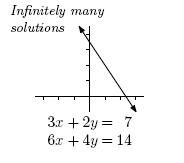Linear equations appear everywhere on the SAT® Math test. In fact, roughly one out of every six questions involves them. Therefore, learning how to write a linear equation, create them, solve them, and interpret their parts saves time and raises scores. This guide breaks the topic into small, friendly steps and includes worked examples plus practice problems.
What We Review
Why Linear Equations Deserve Attention
Linear models help translate real-life scenarios (like calculating paychecks, tracking ticket sales, or measuring speed) into mathematical equations or expressions. On the SAT®, students are rewarded for their ability to efficiently move between word problems and mathematical representations. By developing these skills, students will gain confidence in understanding how to write linear equations, create them from contextual situations, and interpret the meaning of each component within a linear model.
SAT® Checkpoint: What the Test Expects
Each exam typically includes 5 to 7 questions focused on one-variable linear equations. These questions assess a range of skills, including the ability to create an equation based on a given prompt, solve the equation accurately, and interpret the meaning of the solution in context.
Linear equation questions are split between the calculator and no-calculator sections. Approximately half of these questions appear in the calculator section; however, many of them can still be solved more efficiently by hand due to their simplicity. In contrast, the no-calculator section tends to feature problems with cleaner numbers but comes with stricter time constraints, requiring quicker mental math and problem-solving.
The Anatomy of a Linear Equation
- A variable is a placeholder symbol, often x or y, that can represent many numbers.
- A coefficient is the number multiplying the variable. In 7x, the coefficient is 7.
- A constant has no variable attached. It stays the same value.
Example: Identify the parts of 5x-12=3.
- Variable: x
- Coefficient: 5
- Constants: –12 and 3
From Words to Math: How to Write a Linear Equation in Context
To write a linear equation:
- Highlight unknowns & pick variables.
- Spot rate or total relationships.
- Translate comparison words.
- “more than,” “added to” → +
- “less than,” “difference” → –
- “per,” “each,” “every” → × or ÷
Example: Basic Paycheck
Ella earns \$8 per hour and receives a fixed bonus of \$15. After one week, her total earnings amounted to \$87. Write an equation to determine how many hours she worked.
Step 1: Define the variable
Let h represent the number of hours Ella worked during the week.
Step 2: Calculate the hourly earnings
She earns \$8 per hour, so her total hourly earnings are 8h.
Step 3: Add the constant bonus
Ella also receives a bonus of \$15, so we add that to the hourly earnings: 8h + 15.
Final Equation:
The total earnings equal \$87, so the equation is:
Example: Mixture Problem
A chemist needs 30 mL of a 40\% acid solution by mixing a 25\% solution with pure acid (100\%). Write an equation for the total amount of acid in the final mixture.
Step 1: Define the variable
Let x represent the number of milliliters of the 25% acid solution used in the mixture.
Step 2: Express the amount of pure acid
Since the total volume of the mixture must be 30 mL, the amount of pure acid used is 30 - x milliliters.
Step 3: Write the equation for the total acid content
The acid from the 25% solution is 0.25x, and the acid from the pure solution is 1.00(30 - x). Together, they should equal the acid in 30 mL of a 40% solution, which is 0.40(30). So, the equation is:
0.25x + 1.00(30 - x) = 0.40(30)Solving Linear Equations – The Smart Way
Standard Techniques
- Combine like terms.
- Use inverse operations (add, subtract, multiply, divide) to isolate the variable.
Strategic SAT® Shortcuts
- Distribute first to clear parentheses.
- Multiply both sides by the least common denominator to clear fractions fast.
Fluency Drills
Mental checks: If coefficients divide evenly, solve without writing every step. Time saved here adds up on test day.
Example: Solve 3(2x-5)+4=19.
| Step | Reason |
| 3(2x-5)+4=19 | Original equation |
| 6x-15+4=19 | Distribute 3 into the parentheses |
| 6x-11=19 | Combine like terms |
| 6x-11 \color{red}{+11} =19\color{red}{+11} | Add 11 to both sides |
| 6x=30 | Simplify |
| \dfrac{6x}{\color{red}{6}}=\dfrac{30}{\color{red}{6}} | Divide both sides by 6 |
| x=5 | Final answer ✅ |
Special Cases: No Solution, One Solution, Infinitely Many Solutions
When solving an equation, three results may appear.
| Simplified Form | Outcome | SAT® Clue |
| x = a number | One unique solution | Regular |
| A number = a different number | No solution | Parallel lines analogy |
| A number = the same number | Infinitely many | Identical sides |
Example: Solve 2(x+3)=2x+5
| Step | Reason |
|---|---|
| 2(x + 3) = 2x + 5 | Original equation |
| 2x + 6 = 2x + 5 | Distribute 2 into the parentheses |
| 2x + 6 \color{red}{-2x} = 2x + 5 \color{red}{-2x} | Subtract 2x from both sides |
| 6 = 5 | Simplify |
The equation results in a false statement, so there is no value of x that makes it true. Thus, there are no real solutions.
Example: Solve 4(2y-1)=8y-4
| Step | Reason |
|---|---|
| 4(2y - 1) = 8y - 4 | Original equation |
| 8y - 4 = 8y - 4 | Distribute 4 into the parentheses |
| 8y - 4 \color{red}{- 8y} = 8y - 4 \color{red}{- 8y} | Subtract 8y from both sides |
| -4 = -4 | Simplify |
The equation results in a true statement. Therefore, there are infinitely many solutions.
Graphically, equations with infinitely many solutions look like one line on top of another.

Example: Solve 5z+7=3z-9
| Step | Reason |
|---|---|
| 5z + 7 = 3z - 9 | Original equation |
| 5z + 7 \color{red}{-3z} = 3z - 9 \color{red}{-3z} | Subtract 3z from both sides |
| 2z + 7 = -9 | Simplify |
| 2z + 7 \color{red}{-7} = -9 \color{red}{-7} | Subtract 7 from both sides |
| 2z = -16 | Simplify |
| \dfrac{2z}{\color{red}{2}} = \dfrac{-16}{\color{red}{2}} | Divide both sides by 2 |
| z = -8 | Final answer ✅ |
Tip: The SAT® often asks for the number of solutions rather than the solution itself.
Interpreting Solutions in Context
A numeric answer must make sense. Negative hours, for instance, are impossible.
Example: Ticket Sales
A school sold a total of 350 tickets for a fundraiser. Student tickets were sold for \$4 each, and adult tickets for \$7 each. The number of adult tickets sold was \boldsymbol{40} fewer than twice the number of student tickets. If the total revenue collected was \$1{,}940, how many student tickets were sold?
Variable
Let s represent the number of student tickets sold.
Expression for adult tickets
Since there were 40 fewer adult tickets than twice the number of student tickets, we write:
Equation
Total tickets sold:
Simplify and solve this to find s.
| Step | Reason |
|---|---|
| s + (2s - 40) = 350 | Original equation |
| 3s - 40 = 350 | Combine like terms |
| 3s - 40 \color{red}{+ 40} = 350 \color{red}{+ 40} | Add 40 to both sides |
| 3s = 390 | Simplify |
| \dfrac{3s}{\color{red}{3}} = \dfrac{390}{\color{red}{3}} | Divide both sides by 3 |
| s = 130 | Final answer ✅ |
Check reasonableness: 130 adult tickets out of 350 total is possible, and revenue matches.
Common Pitfalls & Test-Day Strategies
- Misplacing negative signs after distribution
- Changing the meaning of a variable mid-problem
- Forgetting to divide both sides by the same coefficient
- Fast verification method: plug the answer back into the original equation
- Notice “SAT®-friendly” numbers such as easy multiples of 5 or 10; they hint at quick arithmetic.
Quick Reference Chart
| Vocabulary | Simple Definition | Key Feature |
| Variable | Symbol that stands for an unknown number | Usually x or y |
| Coefficient | Number multiplying the variable | In 7x, 7 |
| Constant Term | Number without a variable | Stays the same |
| Distributive Property | a(b+c)=ab+ac | Removes parentheses |
| Solution Set | All numbers that satisfy the equation | Could be none, one, or infinite |
| Linear Equation | Equation of degree 1 | Graph is a straight line |
Mini Practice Set
Try these three problems. Answers follow.
- The sum of a number and 12 equals 3 times the number minus 6. Find the number.
- Solve and state the number of solutions: 5(x-2)=5x-10.
- A runner trains by jogging at 6 mph and then sprinting at 10 mph. She runs 8 miles total in 1 hour. How many miles does she sprint?
Answer Key
- x=9
- Infinitely many solutions
- She sprints 5 miles
Wrap-Up & Next Steps
Creating and interpreting linear equations forms the backbone of SAT® Math success. Learn how to write a linear equation by remembering to:
- Assign clear variables.
- Keep the equation balanced.
- Check that the solution fits the story.
Sharpen Your Skills for SAT® Math (Digital)
Are you preparing for the SAT® Math (Digital) test? We’ve got you covered! Try our review articles designed to help you confidently tackle real-world SAT® Math (Digital) problems. You’ll find everything you need to succeed, from quick tips to detailed strategies. Start exploring now!
Need help preparing for your SAT® Math (Digital) exam?
Albert has hundreds of SAT® Math (Digital) practice questions, free response, and full-length practice tests to try out.









